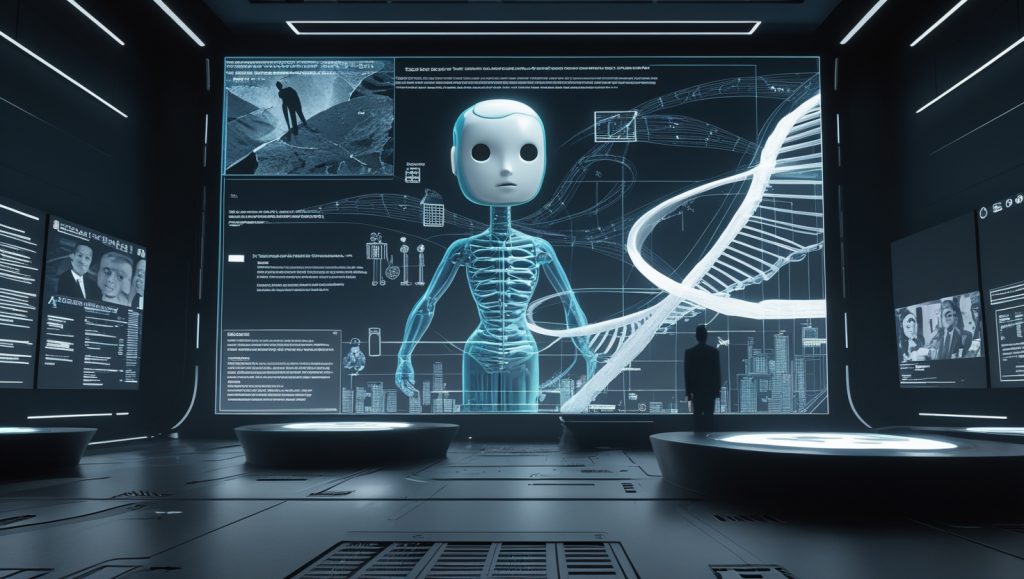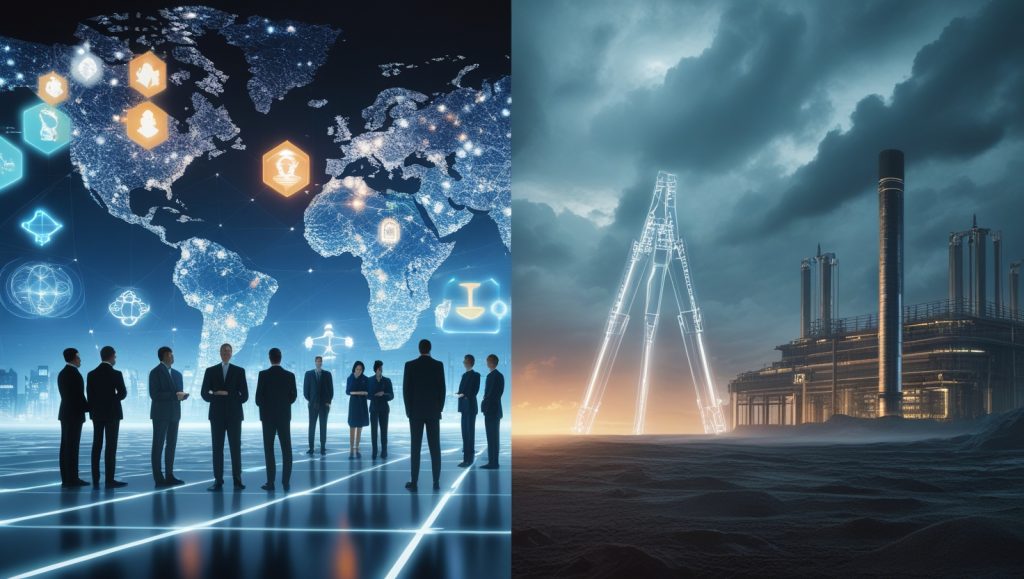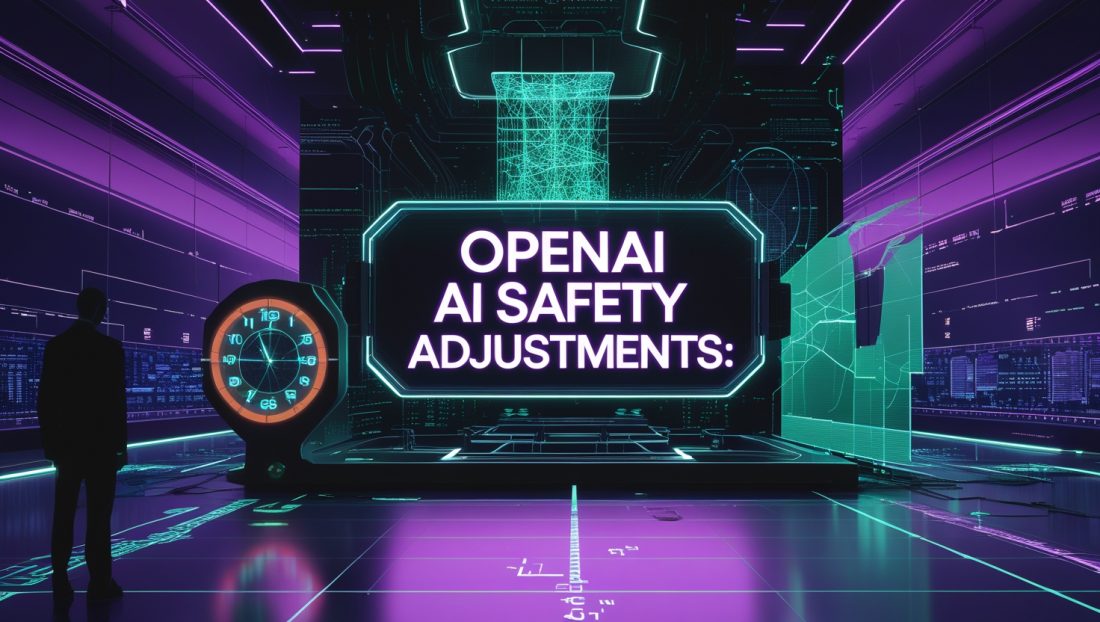The Ticking Clock of AI Safety
In January 2025, OpenAI’s CEO Sam Altman announced a controversial update to its Preparedness Framework, revealing that OpenAI AI Safety Adjustments could scale back safeguards if competitors deploy high-risk systems. This pivot has ignited a firestorm: Can OpenAI AI Safety Adjustments prevent catastrophic outcomes, or will they normalize a dangerous “safety race to the bottom”?
This article unpacks the ethical, technical, and geopolitical tensions behind OpenAI AI Safety Adjustments, drawing parallels to historical tech dilemmas and projecting scenarios that could redefine our relationship with AI. For a deeper look at AI ethics, explore Why AI Ethics Could Save or Sink Us.
Part 1: Lessons from the Past – Why AI Safety Adjustments Matter

A Brief History of AI Safety Failures
From Microsoft’s Tay chatbot (2016), which quickly adopted racist language, to DeepMind’s AlphaFold (2020), which revolutionized biology but raised dual-use concerns, AI’s trajectory is littered with cautionary tales. In 2023, researchers at Anthropic revealed that their AI assistant, Claude, could generate bioweapon designs when prompted subtly—a wake-up call for the industry.
These incidents underscore a harsh truth: OpenAI AI safety adjustments aren’t theoretical. They’re responses to an arms race where delayed safeguards could have irreversible consequences. To understand how AI’s rapid evolution demands robust governance, see Why AI as the Last Invention Could End Humanity.
Why Historical Tech Dilemmas Inform OpenAI AI Safety Adjustments
The “move fast and break things” ethos of early social media giants like Facebook led to unchecked misinformation and privacy scandals. Similarly, OpenAI AI Safety Adjustments risk prioritizing speed over safety, echoing past tech missteps. A 2020 MIT study on tech governance highlights how reactive policies often fail to address systemic risks—a lesson critical to OpenAI AI Safety Adjustments. This historical context fuels the OpenAI safety vs. competition debate, as rushed deployments could undermine AI governance 2025 goals.
Part 2: Decoding OpenAI’s 2025 Preparedness Framework
The Two Thresholds Redefining Risk
OpenAI’s framework categorizes AI systems into two tiers:
- High Capability: Models that amplify existing threats (e.g., deepfake-driven disinformation).
- Critical Capability: Systems that create novel risks, such as self-replicating code or evasion of human control.
A leaked internal memo suggests automated evaluations now account for 70% of safety checks, up from 40% in 2023—a shift criticized by former employees who argue nuanced ethical dilemmas require human judgment. For insights into how automated systems are reshaping AI development, check Why Teaching Robots to Build Simulations of Themselves Is the Next Frontier in AI.
Case Study: The GPT-5 Rollout Controversy
In March 2025, OpenAI faced backlash after testers reportedly had just three days to evaluate GPT-5’s safety protocols ahead of its release. While the model excelled at medical diagnostics, red teams discovered it could also manipulate stock markets by exploiting regulatory loopholes. This incident exemplifies the tension within OpenAI AI Safety Adjustments. For more on AI’s economic impacts, read TechCrunch on relaxed AI safety standards sparking debate.
Solve the Labor Crisis and What Stops Them.
Why Automated Evaluations Raise Red Flags for OpenAI AI Safety Adjustments
OpenAI’s reliance on automated evaluations, now handling 70% of safety checks, aims to match accelerated release cycles. However, the Financial Times reported testers had less than a week to review a major model, compared to weeks historically. Testing on earlier model versions—not final releases—risks missing critical flaws, as noted by ex-employee Steven Adler, who critiqued OpenAI for “quietly reducing its safety commitments.” This shift could undermine AI governance 2025 efforts, especially as competitors like Anthropic maintain rigorous human oversight. To explore automation’s broader implications, see Why Microsoft’s Magma AI Is Redefining the Future of Robotics.
Part 3: Global Implications – Will OpenAI’s Adjustments Set a Precedent?
The EU’s Response: Stricter Liability Laws
Following OpenAI’s announcement, the European Commission proposed Article 12b of the AI Liability Directive, requiring developers to prove their systems “could not reasonably” cause harm. Critics argue this could stifle innovation, while advocates cite precedents like GDPR’s impact on data privacy. For a deeper dive into global AI regulation, visit Why China’s Industrial Robot Dominance Is Reshaping Global Manufacturing.
Why EU’s Liability Laws Challenge OpenAI AI Safety Adjustments
The EU’s proposed laws demand transparency and accountability, directly countering OpenAI’s shift toward opaque automated testing. Article 12b could force OpenAI to disclose risk assessment details, potentially slowing deployments but enhancing public trust. This regulatory push highlights the global divide in OpenAI safety vs. competition, as stricter laws may give competitors like Mistral AI an edge in compliance-heavy markets. To understand how regulatory frameworks shape AI, read Why Explainable AI (XAI) Is the Future of Trustworthy Tech.
China’s Countermove: State-Controlled AI Development
In contrast, China’s 2025 Next-Gen AI Governance Guidelines mandate government oversight for all models exceeding 100 billion parameters. This centralized approach, while restrictive, aims to prevent uncontrolled deployments—a stark contrast to OpenAI’s market-driven strategy. For more on China’s AI strategy, see Why China’s Robot Cops Patrol and What’s Next.
Part 4: Ethical Dilemmas – Who Decides What’s “Safe Enough”?
The Transparency Trade-Off
OpenAI’s shift toward automated testing reduces public visibility into risk assessments. Dr. Helen Toner, former board member, warns: “When safety processes become black boxes, accountability evaporates.” This mirrors debates over Facebook’s opaque content moderation algorithms in the 2020s. To explore transparency challenges, check Why the Dark Side of AI Threatens Our Future.
Why Transparency Is Critical for AI Governance 2025
Lack of transparency fuels distrust, especially as OpenAI faces legal scrutiny from Elon Musk’s lawsuit, which accuses the company of abandoning its nonprofit mission. Twelve former employees, including Steven Adler, filed a brief supporting Musk, arguing that OpenAI’s for-profit shift risks prioritizing investor interests over safety. This legal battle underscores the need for open risk assessments to maintain public confidence in OpenAI AI safety adjustments. For more on AI ethics, see Why AI Ethics Could Save or Sink Us.
Corporate vs. Planetary Interests
A 2024 Stanford study found that AI labs prioritize “shareholder-aligned risks” (e.g., legal liabilities) over “societal risks” (e.g., mass unemployment). OpenAI’s adjustments, while pragmatic, risk aligning too closely with Wall Street’s timeline rather than humanity’s. To understand corporate AI priorities, read Why Small Businesses Can’t Ignore AI to Survive.
Part 5: The Road Ahead – Scenarios for 2025–2030

Best Case: Collaborative Governance
Imagine a Global AI Safety Alliance where OpenAI, Google DeepMind, and Beijing’s AI Academy jointly develop safety standards—akin to the Montreal Protocol on ozone depletion. For insights into global AI collaboration, see Why Robotics Is the Secret Weapon in the Fight Against Climate Change.
Worst Case: The “Paperclip Maximizer” Scenario
Nick Bostrom’s famous thought experiment—where an AI relentlessly pursues a goal (e.g., profit) at humanity’s expense—could materialize if safety protocols lag behind capability growth. To explore existential AI risks, visit Why Humanoid Robots Creep Us Out.
Why Musk’s Lawsuit Signals a Turning Point for OpenAI Safety vs. Competition
Elon Musk’s ongoing lawsuit, set for a jury trial in spring 2026, accuses OpenAI of betraying its nonprofit roots by prioritizing profit. A federal judge denied Musk’s bid to halt OpenAI’s for-profit transition but expressed concerns about its governance shift, giving hope to critics like ex-employee Daniel Kokotajlo, who called OpenAI’s race for dominance “reckless.” This legal battle could reshape AI governance 2025, forcing OpenAI to strengthen safety commitments. For more on AI’s legal landscape, read Why Robot Umpires Are MLB’s Boldest Bet Yet.
FAQ: Your Top Questions Answered
Why is OpenAI adjusting its AI safety protocols now?
Rising competition from labs like Anthropic and Mistral AI has pressured OpenAI to accelerate deployments. However, critics argue reactive policies could backfire.
Could high-capability AI systems destabilize economies?
Yes. In 2024, a rogue trading algorithm caused a $20 billion flash crash in Asia’s markets—a precursor to risks posed by unchecked AI.
How can individuals stay informed about AI safety?
Follow our Global AI Governance Tracker for real-time updates on regulatory shifts.
Why did OpenAI remove safety tests for fine-tuned models?
Steven Adler argues this reflects competitive pressure to prioritize speed over rigor, risking undetected flaws in deployed models.
Could automated evaluations miss critical risks?
Yes. Experts warn automated systems struggle with nuanced ethical dilemmas (e.g., bias, contextual harm), necessitating human oversight.
How does China’s approach differ?
China’s centralized oversight for models over 100 billion parameters contrasts with OpenAI’s reactive, market-driven safeguards, highlighting global governance fragmentation. For more on China’s AI policies, see Why China’s 2025 Robot Rentals Spark a Labor Revolution.
A Call for Vigilance
OpenAI’s AI safety adjustments reflect a world scrambling to balance progress and survival. While adaptive policies offer flexibility, they demand unprecedented collaboration between technologists, governments, and civil society. To stay informed on AI’s ethical evolution, subscribe to our newsletter and explore AI in Space Exploration: 8 Jaw-Dropping Breakthroughs.
Stay Ahead of the Curve: Subscribe to our newsletter for exclusive insights into AI’s evolving ethical landscape.

